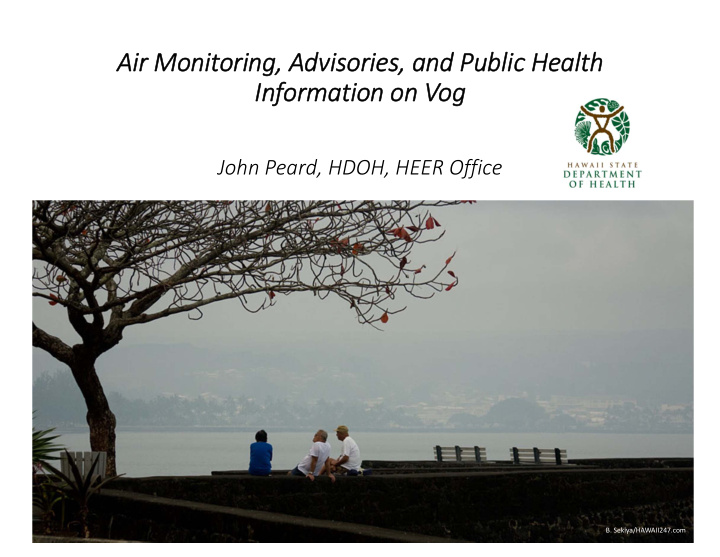



Air Monitoring, Advisories, and Public Health Information on Vog John Peard, HDOH, HEER Office B. Sekiya/HAWAII247.com
HDOH Air Monitoring Station on Konawaena School Road, Upper Campus of the High School
http://www.hiso2index.info/assets/FinalSO2Exposurelevels.pdf
SULFUR DIOXIDE ACTION PLAN CONDITION SCHOOL ACTION 1) Maintain normal school operations Green 2) Monitor air quality Good 3) Notify health room if staff/students are in need of medical attention 0.0 – 0.2 4) Affected staff/students will be evaluated by school health aide with reference to Respiratory ppm Action Plan (RAP) 1) Maintain normal school operations Yellow 2) Monitor air quality Moderate 3) Notify health room if staff/students are in need of medical attention 0.2 – 0.4 4) Affected staff/students will be evaluated by school health aide with reference to Respiratory Action Plan (RAP) ppm 5) Updates will be made every hour or as needed Orange 1) Limit outdoor exposures by conducting indoor activities (Recess, PE) 2) Conduct Shelter in Place Procedures Unhealthy for 3) Monitor air quality Sensitive 4) Notify health room if staff/students are in need of medical attention Groups 5) Affected staff/students will be evaluated by school health aide with reference to Respiratory 0.4 – 1.0 Action Plan (RAP) ppm 6) Updates will be made every hour or as needed Red 1) Limit outdoor exposures by conducting indoor activities (Recess, PE) 2) Monitor air quality Unhealthy 3) Notify health room if staff/students are in need of medical attention 1.0 – 3.0 4) Affected staff/students will be evaluated by school health aide with reference to Respiratory Action Plan (RAP) ppm 5) Updates will be made every hour or as needed 1) Conduct Shelter in Place (School ‐ Wide Safer Room Procedure) Purple 2) Monitor air quality Very 3) Notify health room if staff/students are in need of medical attention Unhealthy 4) Affected staff/students will be evaluated by school health aide with reference to Respiratory 3.0 – 5.0 Action Plan (RAP) 5) Updates will be made every hour or as needed ppm 6) Communicate with district office on current conditions and next steps Maroon 1) Conduct Shelter in Place (School ‐ Wide Safer Room Procedure) 2) Monitor air quality Hazardous 3) Notify health room if staff/students are in need of medical attention 5.0+ 4) Affects staff/students will be evaluated by school health aide with reference to Respiratory Action Plan (RAP) ppm 5) Updates will be made every hour or as needed 6) Communicate with district office on current conditions and next steps
Claire Horwell
Updated Public Information on Vog – August 2016
Sensitive Groups • People with Asthma or other Respiratory Conditions • People with Cardiovascular Disease • Older Adults • Infants and Children • New/Expectant Mothers
Vog Symptoms Sulfur Dioxide Gas Fine Particle Pollution • Eye, Nose, Throat, and/or Skin Irritation • Eye, Nose, and/or Throat Irritation • Coughing and/or Phlegm • Coughing and/or Phlegm • Chest Tightness and/or Shortness of • Chest Tightness and/or Shortness of Breath Breath • Headache • Increased Susceptibility to Respiratory Ailments • Some people report fatigue and/or dizziness
What Can You Do to Protect Yourself from Harmful Effects of Vog? • Sensitivity varies – protect yourself and family, as necessary • Individuals in sensitive groups expected to be at highest risk • Prepare for vog exposure by understanding the hazard, learn about winds and vog conditions, keep medications at hand if you have asthma or other respiratory conditions • Get medical help if you are having symptoms (like trouble breathing) • Limit exercise/strenuous activities, especially outdoors, when vog is elevated • Don’t smoke, avoid second ‐ hand smoke • Stay Hydrated and Manage Congestion/Irritation • Stay indoors and close doors windows, watch out for other sources of indoor pollutants and heat • Create a room/area where a room air cleaner may reduce vog impacts • Leave the area, if necessary • When visiting Hawaii Volcanoes National Park, follow signs and Park Ranger advice
• Periodic Meetings of Two Inter ‐ agency Groups • Continue/Enhance Vog Monitoring and Prediction • Develop and Foster Research Projects and Infrastructure • Continue to Update and Improve Public Outreach Materials
Recommend
More recommend